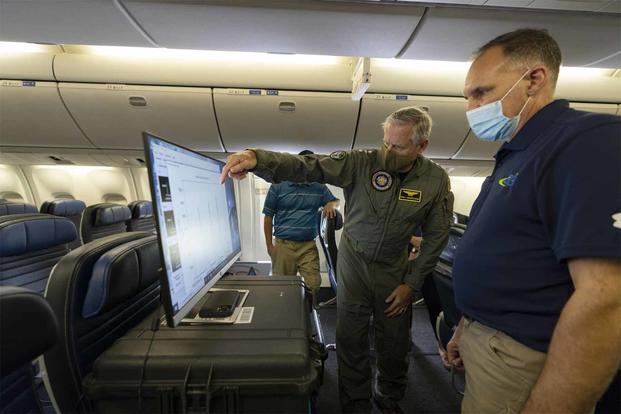A new military-led study unveiled Thursday shows there is a low risk for passengers traveling aboard large commercial aircraft to contract an airborne virus such as COVID-19 -- and it doesn't matter where they sit on the airplane.
Researchers concluded that because of sophisticated air particle filtration and ventilation systems on board the Boeing 767-300 and 777-200 aircraft -- the planes tested for the study -- airborne particles within the cabin have a very short lifespan, according to defense officials with U.S. Transportation Command, the Defense Advanced Research Project Agency (DARPA) and Air Mobility Command, which spearheaded the study.
Read Next: Air Force OKs New Stormbreaker Bomb for F-15 Strike Eagle Operations
"The favorable results are attributable to a combination of the airframes' high air exchange rates, coupled with the high efficiency particulate air (HEPA) filtration recirculation systems, and the downward airflow ventilation design which results in rapid dilution and purging of the disseminated aerosol particles," Vice Adm. Dee L. Mewbourne, deputy commander of U.S. Transportation Command, said during a virtual roundtable with reporters.
DARPA teamed up with biodefense company Zeteo Tech, scientific research company S3i and the University of Nebraska's National Strategic Research Institute (NSRI) for the trials. Industry partners included Boeing and United Airlines.; the study was funded by TRANSCOM, according to Army Lt Col Ellis Gales, spokesman for the command.
"All areas on both aircraft proved to be extremely effective in dispersing and filtering out the aerosol particles," said Navy Lt. Cmdr. Joseph Pope, TRANSCOM Operations directorate liaison for the airflow particle test. "So specifically, can I tell you to sit in seat XYZ? No; they all performed very well."
During the tests, held Aug. 24-31, analysts released two types of aerosols that had specific DNA signatures. The tagged fluorescent tracers allowed for researchers to better follow their distribution path, both in flight and on the ground.
Sensors throughout the aircraft measured over 300 iterations of aerosol releases -- at rates of 2 to 4 minutes -- across four cabin zones on the 777, and three zones on the 767, Mewboourne explained. The dispersions were mapped in real-time, he said.
The particles were quickly diluted, however, and only remained detectable for fewer than six minutes on average, TRANSCOM said in the report. By comparison "a typical American home takes around 90 minutes to clear these types of particles from the air," the command said.
While the more time spent on an aircraft correlates to a potential infection rate, according to the study, even passengers on long-haul flights wouldn't be able to pick up a sufficient viral load under the test conditions. Passengers traveling on board the 777 would need to spend at least "54 hours when sitting next to an index patient in the economy section," and more than 100 hours in the other cabins of both the 777 and the 767 to be exposed to an infectious dose, the study said.
Mannequins representing passengers were positioned throughout the aircraft, some wearing masks and some without. David Silcott of S3i and one of the authors of the report said the dispersed mannequins were part of both breathing and cough tests.
During the simulated cough tests, masked mannequins showed a "very, very large reduction in aerosol that would come out of [them], greater than 95% for most cases," Silcott said. "It definitely showed the benefit of wearing a mask inflight from these tests."
Pope said it is important to consider that the study was specific to aerosols and not ballistic droplets, those that are emitted while coughing, sneezing or breathing heavily.
That said, "the mask is very important in that the larger droplets that travel ballistically through the air will be caught by your mask," Pope said. "And if you don't have the mask on, then you cannot reduce those numbers of ballistic particles."
Scientists also collected samples from surfaces like armrests and video screens, considered "high-touch" zones; the tests showed that while the distribution on surfaces was minimal, flat surface areas -- like armrests -- are more likely than vertical surface areas like seatbacks or screens to collect deposits of particles.
There are other caveats: The scientists didn't try to simulate passengers freely moving about the cabin, moving around to switch locations or turning toward one another to have a conversation.
"While ... we're very encouraged by the results, that's part of the reason why we're making the results public, and sharing them with the scientific community so that that follow-on research can be done," Pope said.
The study next heads into a peer review before its findings can be submitted for a scientific journal. TRANSCOM is examining the results, which could spur new travel policies or proposals, Pope said.
Following the onset of the coronavirus pandemic in March, TRANSCOM identified an immediate need to move passengers in a safe manner, including high-risk patients as well as military members and families traveling aboard the Defense Department-contracted Patriot Express flights. The two Boeing aircraft used for the aerosol simulations are the aircraft most typically used for Patriot Express flights.
The officials stressed service members should still follow current Centers for Disease Control and Prevention guidelines and airline protocols when boarding a flight.
-- Oriana Pawlyk can be reached at oriana.pawlyk@military.com. Follow her on Twitter at @Oriana0214.
Related: DoD Test of Viral Spread on Commercial Planes Reveals Good News, General Says












